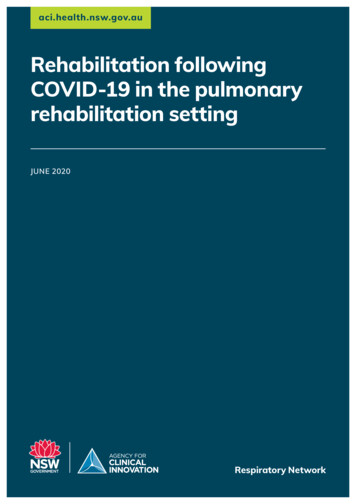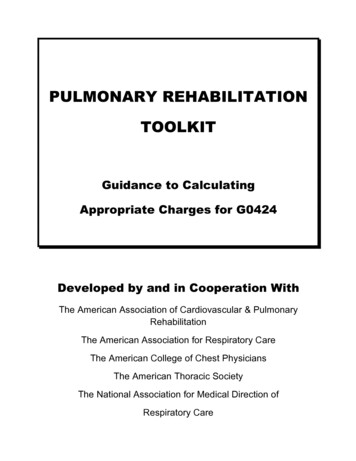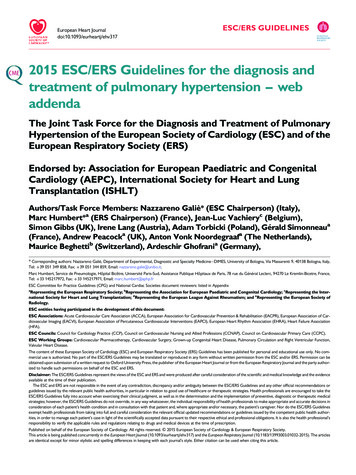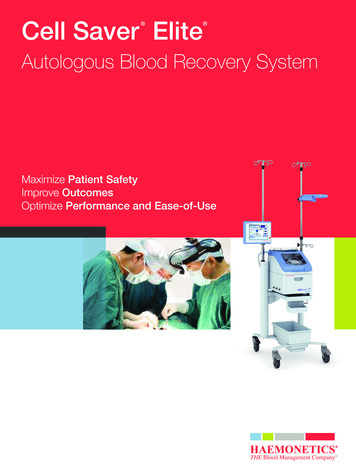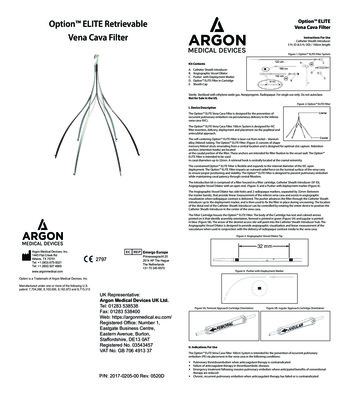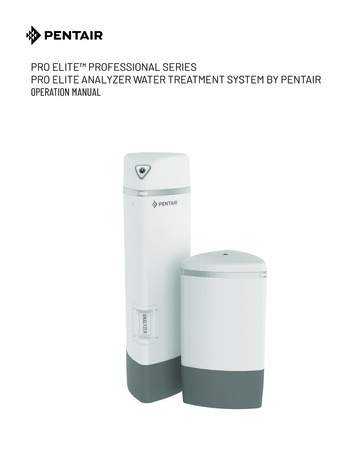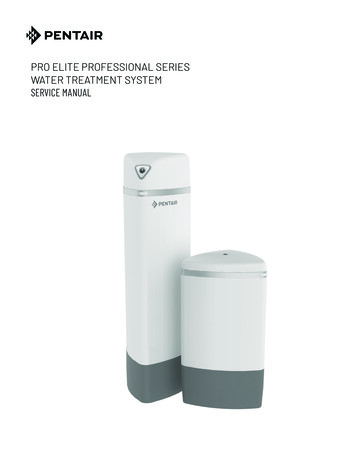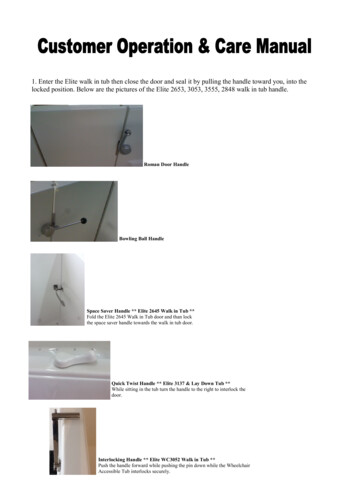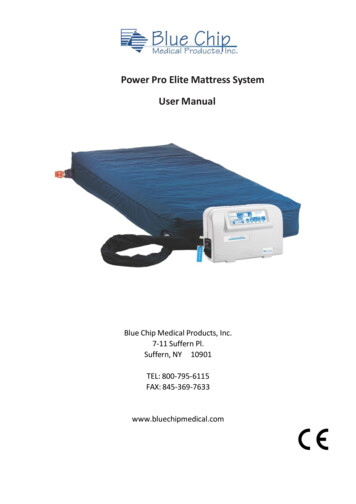
Transcription
Patient Education:Pulmonary RehabilitationA Guide to Managing Chronic Lung Disease through Exercise and Education Staying Active With COPD: Get started with exercises thatmake it easier for you to breathe Pulmonary Rehab for Beginners: What can you expect on your first day? Fit for Life: Keep up with pulmonary rehabilitation exercises at home Smart Thinking for Patients With COPD: Reduce your symptomflare-ups and stay out of the hospital Getting With the COPD Management Program: A look at resourcesthat can help you manage your COPD ]fiI\jgëiXkfip :Xi\ Jc\\g D\[ Z e\ View and print this and other patient handouts on our website, www.advanceweb.com/respiratory
IntroductionStaying ActiveWith COPDThe Best MedicineAt one time, people who had chronic lung disease and becameshort of breath when active were told to go home and rest becausethere wasn’t much that could be done for them. We now know thatisn’t true. Pulmonary rehabilitation is considered the best medicinefor people with chronic obstructive pulmonary disease (COPD).Patients participating in a pulmonaryrehab program learn to control their shortness of breath by using different breathing techniques. They learn about theirlung disease and medications, learn howto recognize infections so they can startan action plan and avoid hospitalization,and begin an exercise program to buildtheir strength and endurance. Perhapsmost importantly, they say, “Yes, I can,” toparticipating in activities and experience an improved quality of life.Pulmonary rehabilitation is a recognized Medicare benefit forpatients with COPD. However, patients with restrictive lung diseasemay also be good candidates. These patients should check with theirlocal pulmonary rehab program about reimbursement. n— June Schulz, RRT, FAACVPRPulmonary Rehabilitation CoordinatorSanford Health, Sioux Falls, S.D.Pulmonary Rehabfor BeginnersFit for LifeSmart Thinking forPatients With COPDGetting With theCOPD ManagementProgram ]fiI\jgëiXkfip :Xi\ Jc\\g D\[ Z e\ View and print this and other patient handouts on our Web site, www.advanceweb.com/respiratory
PAtient primerBy Lauren Constance EveringhamGet started with exercises that make it easier to breatheSimple tasks like getting up from achair can leave people with chronic obstructive pulmonary disease breathless. So theymay think exercise is out of the question.On the contrary, it’s important for eventhose with advanced lung disease to stayactive. When you exercise, your muscles getstronger. Strong muscles need less oxygen.Therefore, exercising actually makes it easierfor you to breathe.Get startedIt’s important to start slowly. Some people maybegin with a few minutes a day, while othersare able to do more. Remember to speak withyour doctor before beginning an exerciseprogram. He or she can help you decide whatlevel is right for you.Setting goals helps you stick with yourprogram. Be sure your first goal is one you knowyou can meet, and then gradually work up tolarger goals. Eventually, you’ll want to be ableto exercise for 20 to 30 minutes repeated threeto five times a week. But if you try to do thatmuch in the beginning, you might give up.A pulmonary rehab program can help youget the most out of exercise. In addition tophysical training, rehab programs offer nutrition counseling and education. Plus, programsoffer support and supervision for those whoaren’t confident exercising on their own.ready for the pulmonary rehab session.First, inhale through your nose so yourstomach muscles expand, and then exhalethrough your mouth with your lips pursed. It’simportant to exhale twice as long as you inhale.Practice the technique for 5 minutes. Once youget the hang of it, you should do pursed-lipbreathing during exercise as well.After warming up, perform your mainaerobic activity such as swimming, walking,biking, etc. If you need oxygen therapy duringexercise, be sure and use it throughout yourworkout. Pick activities you enjoy, and alternatethem so you’re more likely to stay motivated.Resistance training (lifting a light weightwith your arms and legs) is important for makingmuscles stronger and increasing endurance. Thiscan help you reduce fatigue and reverse deconditioning. Finally, be sure to end your workoutwith a cool-down activity, which can be stretching, or walking or swimming at a slower pace.RewardsEven the smallest amount of exercise is betterthan none at all. An active lifestyle increasesyour physical capacity even though impairedlung function continues to persist after exercisetraining. An exercise regimen will give you moreconfidence and independence, and make dailyactivities like shopping and cooking easier. nInformation adapted from University of PittsburghMedical Center, American Association for RespiratoryCare, and American College of Sports Medicine.Get goingAlways begin exercise with a warm-up period.While simple stretching warms up yourmuscles, pursed-lip breathing gets your lungsEDITOR’S NOTE:Your doctor or therapisthas given you this patient education handout tofurther explain or remind you about an issue relatedto your health. It is a general guide only. If you havespecific questions, discuss them with your doctoror therapist. ]fiI\jgëiXkfip :Xi\ Jc\\g D\[ Z e\ View and print this and other patient handouts on our website, www.advanceweb.com/respiratoryscott derbyStaying Active With COPD
PAtient primerBy Kristen ZieglerPulmonary Rehabfor BeginnersWhat to expect on your first dayStarting a pulmonary rehabilitation program is likegoing to school. The “classes” address subjects such as administeringmedications, stress management, and smoking cessation. The “teachers”are a multidisciplinary team of health care professionals.But you don’t have to be a whiz kid for pulmonary rehabilitationto help manage your symptoms and slow the progression of yourpulmonary disease. While results vary, the goal is to increase yourindependence, decrease your hospitalizations, and improve yourquality of life.What to expectExercise trainingAs your weeks of pulmonary rehabilitation progress, you will practicea regimen of stretching, aerobic activities like walking, and strengthexercises using free weights and resistance bands. A typical exerciseprescription emphasizes endurance training for 20 to 30 minutesrepeated three to five days a week.It’s important to exercise at home as well. This “homework”includes walking, bicycling, swim m ing, or other activitiesrecommended by your rehabilitation team. Keep up this routine evenafter completing rehabilitation to ensure its long-term effectiveness.Patients who stop exercising following rehabilitation typi cally returnto their previous state of health within 12 to 18 months.The rehabilitation team al so will show you how to con serve energyand pace yourself during exercise and daily ac tivities. They willdemonstrate strategies to help reduce your shortness of breath.Increasing AwarenessA comprehensive pulmo nary rehabilitation program will teach you topay attention to your body. You’ll learn to prevent respiratory infections by avoiding crowds, getting flu or pneumonia shots, and usingantibacterial wipes or gels.Medicare pays for 36 hours of pulmonary rehab sessions. Moremay be available if clinically warranted. Program costs vary greatlyby location, but many therapies are covered by insurers. Check withyour local pulmonary rehabilitation provider for further information.With a little effort, you’re sure to graduate pul monary rehab withflying colors. Just don’t forget the homework. nInformation provided by Lana Hilling, RCP, FAACVPR, pulmonaryrehabilitation coordinator of John Muir Health in Concord, Ca. andadapted from National Lung Health Education Program guidelines.EDITOR’S NOTE: Your doctor or therapist has given you thispatient education handout to further explain or remind you aboutan issue related to your health. It is a general guide only. If you havespecific questions, discuss them with your doctor or therapist. ]fiI\jgëiXkfip :Xi\ Jc\\g D\[ Z e\ View and print this and other patient handouts on our website, www.advanceweb.com/respiratorytom whalenThe structure of pul monary rehab programs varies; the majority ofprograms are held as group classes, but some are done individually.Most programs encour age family or friends to attend with you.Before you begin, a pulmonary rehabilitation team member willtalk with you about your chronic lung disease and its physical andemotional effect. They will determine whether you need testing suchas pulmonary function tests and chest X-rays. They also may haveyou take a short quiz about lung diseases and ask you to set goals foryour progress.For your first class, wear comfortable clothing and walking shoes.Make sure to bring your fast-acting inhaler, supplemental oxygenequipment, and other prescribed medications.A staff member will measure the distance you are able to walk insix minutes while a device called a pulse oximeter determines theamount of oxygen in your blood through a clip on your finger ora forehead sensor. The test results will help the rehabilitation teamassess your functional exercise capacity and develop an exerciseprogram tailored to your abilities.
PAtient primerBy Colleen MullarkeyFit for LifeKeep up with pulmonary rehabexercises at homeSafety firstWhile a regular exercise routine is important, be careful not to overdoit. Your pulmonary rehab team will identify stretching and warm-upexercises that start at a low intensity and then gradually increase yourheart and breathing rates. At the end of your exercise routine, it’s alsoimportant to slow your pace for five minutes to cool down.Watch for signs of a possible exacerbation. The providers at yourpulmonary rehab program can help you become familiar with yourbreathing levels and what to do if you experience shortness of breath.If you use long-term supplemental oxygen, your pulmonaryrehabilitation team will determine which oxygen flow rates youshould use dur ing periods of rest and exercise. They may recommendthat you use a fingertip pulse oximeter at home to occasionally assessyour oxygen level.Finally, listen to your instincts. If something doesn’t feel right, stopdoing it immediately, and call your primary health care provider. Youmay need to limit your activities until the problem is resolved.Regular exercise has many benefits. The stronger the muscles youuse for breathing become, the more efficiently your body will use oxygen. Staying fit also can help lower blood pressure, lose weight, andmanage stress. Keep up the progress you made in pulmonary rehabby following an exercise routine that is convenient and enjoyable. nInformation provided by Peter J. Rising, MS, manager of thepulmonary function laboratory at Temple University Health System,Philadelphia.EDITOR’S NOTE: Your doctor or therapist has given you thispatient education handout to further explain or remind you aboutan issue related to your health. It is a general guide only. If you havespecific questions, discuss them with your doctor or therapist. ]fiI\jgëiXkfip :Xi\ Jc\\g D\[ Z e\ View and print this and other patient handouts on our website, www.advanceweb.com/respiratoryTOM WHALENFitness buffs will tell you their workouts don’t endafter they leave the gym. Staying in shape means making changesat home too. The same goes for pulmonary rehabilitation. A homeexercise routine can help to maintain your lung function and improveyour overall well-being.Think of your pulmonologist, respiratory therapist, andprimary care physician like a team of personal trainers. A pulmonaryrehabilita tion program is a great place to learn how to do the properexercises with a health care professional’s guidance and expertise.They’ll create an at-home exercise plan and suggest lifestyle changes tohelp you to reach long-term goals after your formal pulmonary rehabsessions end.Talk with your pulmonary rehab team about your living situationand surroundings. Perhaps you already have a treadmill, stationary bike, or light free weights to use at home. If you don’t, they cansuggest resources in your area such as a community or senior centerthat has exercise equipment.They also can recommend simple strategies to fit in therecom mended 20 minutes of continuous walking a day. You coulddo laps at a local mall or high school track, stroll around your blockor apartment building, or even just walk the length of your hallway afew times.While aerobic exercise focuses on your cardiovascular endurance,strength training keeps your upper body in shape. Some people liketo use light free weights or resistance bands; others use items fromtheir pantry like soup cans or water bottles. Your pulmonary rehabteam will advise you on the ideal amount of weight, type of exercise,and number of repetitions to improve your strength and muscle tone.When you leave a formal pulmonary rehab program, you maymiss the social support and motivation that it offered. Signing up fora gym membership, finding a workout buddy, or making an arrangement with a family member can increase the chances that you’ll stickwith the routine.
PAtient primerBy Frank ViscoSmart Thinking forPatients With COPDAvoid hospitalization and improve healthKnowing symptoms and triggersFor starters, you should know the symptoms of an exacerbation, so thatyou’ll recognize when you’re actually having one. Symptoms includeincreased or prolonged breathlessness, coughing, sputum (mucus)production, wheezing, chest tightness, and fever. Keep track of howmany and how severe your symptoms are, and share this informationwith your physician. A simple breathing test called spirometry can helpto determine if your lung function is declining.In addition, you should become aware of what aggravates your COPD.Evidence suggests 80 percent of COPD exacerba tions are infectious inorigin, so practice good hand hygiene, and avoid people with colds orother respiratory illnesses.1 Make sure you get your annual flu shotbecause the vaccine can decrease serious complications and death inCOPD patients by as much as 50 percent.2 Ask your physician if you’rea good candidate for the pneumonia vaccine as well.Pollution is another major trigger of ex acerbations for people withCOPD, so min imize exposure to environmental irritants such as dust,chemicals, and secondhand smoke. Stay inside on high ozone days.Healthy livingProactive approaches like a balanced diet, a good night’s sleep, andmaintaining a healthy weight are good ideas for anyone, but they canbe especially valuable to COPD patients who want to improve theirquality of life. It’s also wise to make an effort to keep your emotions incheck, because depression and anxiety can lead to a higher frequencyof exacerbations.3Exercise in the form of pulmonary rehabilitation is suggested forpeople looking to avoid exacerbation relapse because pulmonaryfunction declines after each episode. Staying active can help strengthenthe muscles you use to breathe.But the most important lifestyle change you can make is toquit smoking to slow the progression of lung inflammation thatcauses COPD.Managing therapiesFollowing the medication plan prescribed by your doctor is anothersimple way to manage your disease. Take your mainte nance medicationsdaily to keep symptoms under control and reduce your need for res cuemedications. If you use supplemental oxygen, be sure that you’re usingthe appropriate levels prescribed for periods of activity and rest.Remember, despite your best efforts to prevent them, COPDexacerbations are common and can occur suddenly. Be sure toknow how and when to use your rescue medications, and go to theemergency room if necessary. nReferences1. Soto FJ, Varkey B. Evidence-based approach to acute exacerbations of COPD. Curr Opin Pulm Med. 2003; 9(2):117-24.2. Trendel D. What is a COPD exacerbation. About.com. July2008. Available from http://copd.about.com/od/copd/a/copdexac.htm.3. Xu W, Collet J, Shapiro S, Lin Y, Yang T, Platt RW, et al.Independent effect of depression and anxi ety on chronic obstructivepulmonary disease exacer bations and hospitalizations. Am J RespirCrit Care Med. 2008;178(9):913-20.EDITOR’S NOTE: Your doctor or therapist has given you thispatient education handout to further explain or remind you aboutan issue related to your health. It is a general guide only. If you havespecific questions, discuss them with your doctor or therapist. ]fiI\jgëiXkfip :Xi\ Jc\\g D\[ Z e\ View and print this and other patient handouts on our website, www.advanceweb.com/respiratoryDAVE PERILLOChronic obstructive pulmonary disease, like a forceof nature, can’t really be stopped. But if a hurricane was coming yourway, you wouldn’t just sit around twiddling your thumbs, right?Odds are you would board up the windows, pack up the china, andso forth in your best effort to minimize the damage. It’s to your benefitto approach COPD in the same way. You can take measures to reducethe risk of exacerbations — serious symptom flare-ups that can land youin the hospital and lead to debilitating or even fatal complications.
PAtient primerBy Colleen MullarkeyGetting With theCOPD ManagementProgramMany employers and health insurance plans now offer diseasemanagement programs for a number of medical conditions. You mighthave heard about some for weight management or diabetes care, butdid you know there also are many to help you manage your chronicobstructive pulmonary disease (COPD)? More companies have beenadding COPD disease management programs to their list of benefits,so let’s take a look at what they have to offer.A quick reviewCOPD disease management programs combine a number of ways tohelp you improve control of your COPD symptoms and lessen harmfuleffects. Disease management professionals use a team approach to carerather than just giving you directions. They work with you to improveyour treatment plan, watch your progress, and often provide supportafter hours.Some programs send a health care professional to meet with youregularly at your home and then follow up with phone calls or emailsin between visits. Others don’t require any face-to-face meetings. Theymight send you educational materials by mail and check your progressby phone or email.The length and make-up of the program usually depend on the stageof your disease and the amount of time you’re willing to commit. Forsome people, it might last a few months, while others choose to continue for a few years. As you progress, your health care providers willtailor the program to fit your changing needs.Tests, tips, and techniquesEven though you’ll find differences in how care is provided throughthese programs, you’ll find they share the same basic ideas. The firststep in any COPD disease management program is a general review ofyour health to figure out what level of care you need.Health care providers will check basic vital signs and performmore specific tests to examine your lungs, breathing, exercise levels,and oxygen.A simple test called spirometry measures how much air you canbreathe in and out, and how fast you can blow the air out of your lungs.A finger probe called a pulse oximeter also can measure the oxygenlevels in your blood.They’ll use these and other results to help you come up with goalsand a personalized plan to recognize your symptoms and steer clear ofrisks like smoking, dust, and people who are not well.This might include lifestyle changes like quitting smoking, a healthydiet, exercise, and flu shots every year. Overall, they’ll teach you howto use your medications, how to stick with your treatment, and how totrack and respond to your symptoms.If you’re looking for something a little more intense and hands-on,find out if your health insurance offers coverage for pulmonaryrehabilitation programs. They incorporate similar lessons but providemore direct contact with medical professionals, usually through two tofour visits at a medical facility each week.Many resources are available to help you manage your disease. Regardlessof which one you choose to use, working to get your disease under controlis the first step to improving your health and quality of life. nInformation provided by Jakki Grimball, MA, RRT, AE-C, asthma andCOPD program administrator at BlueChoice HealthPlan.EDITOR’S NOTE: Your doctor or therapist has given you thispatient education handout to further explain or remind you aboutan issue related to your health. It is a general guide only. If you havespecific questions, discuss them with your doctor or therapist. ]fiI\jgëiXkfip :Xi\ Jc\\g D\[ Z e\ View and print this and other patient handouts on our website, www.advanceweb.com/respiratoryTOM WHALENA look at resources that can help youmanage your COPD
Medicare pays for 36 hours of pulmonary rehab sessions. More may be available if clinically warranted. Program costs vary greatly by location, but many therapies are covered by insurers. Check with your local pulmonary rehabilitation provider for further information. With a little effort, you're sure to graduate pul monary rehab with flying .
